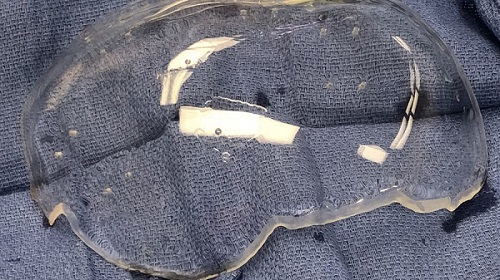Functional Ultrasound Imaging Records Brain Activity through Transparent Skull Implant
Posted on 30 May 2024
Functional brain imaging, which captures brain activity data by measuring changes in blood flow or electrical impulses, provides crucial insights into brain function for both healthy individuals and those with neurological disorders. However, existing techniques like functional magnetic resonance imaging (fMRI) and intracranial electroencephalography (EEG) have limitations, including low resolution, lack of portability, and the requirement for invasive surgery. Functional ultrasound imaging (fUSI) is now emerging as a sensitive and precise alternative that could address these issues.
In the first study of its kind led by the Keck School of Medicine of USC (Los Angeles, CA, USA) and the California Institute of Technology (Caltech, Pasadena, CA, USA), researchers have designed and implanted a transparent window into the skull of a patient. This was followed by the use of fUSI to gather high-resolution brain imaging data through this window. Preliminary results indicate that this non-invasive method could revolutionize patient monitoring, clinical research, and our understanding of brain function.

Building on earlier work where the team developed specialized ultrasound sequences for measuring brain function and optimizing brain-computer interfaces, they tested various transparent skull implants on rats. A thin window made of polymethyl methacrylate (PMMA), similar to plexiglass, provided the best imaging clarity. Subsequently, a custom implant was created to explore the potential of fUSI in a research participant recovering from a traumatic brain injury (TBI).
Prior to the reconstructive surgery, the researchers fine-tuned fUSI parameters using a phantom (a device used to test medical imaging equipment) and animal models. They then monitored the patient’s brain activity through fUSI during tasks performed both pre-surgery and post-implantation of the clear window. fUSI not only offered sharper resolution than fMRI but, unlike intracranial EEG, it avoids the need for internal brain electrodes. It also costs less than these methods and could provide clinical benefits over opaque skull implants.
The novel technique also holds promise for broader studies on TBI and other neurological conditions, as well as the ability to observe the healthy brain's management of cognitive, sensory, motor, and autonomic functions. Although fUSI and the clear implant remain experimental pending clinical trials, the research team is actively working to refine their fUSI techniques to enhance imaging resolution further. They plan future studies involving more participants to better establish the connection between specific brain functions and fUSI data.
“This is the first time anyone had applied functional ultrasound imaging through a skull replacement in an awake, behaving human performing a task,” said Charles Liu, MD, PhD, a professor of clinical neurological surgery, urology and surgery at the Keck School of Medicine and director of the USC Neurorestoration Center. “The ability to extract this type of information noninvasively through a window is pretty significant, particularly since many of the patients who require skull repair have or will develop neurological disabilities. In addition, ‘windows’ can be surgically implanted in patients with intact skulls if functional information can help with diagnosis and treatment.”
Related Links:
Keck School of Medicine of USC
Caltech














